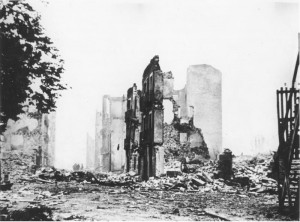Our last series, Flesh, Fakers and Fountains, Oh My! Scandals in Art, looked at famous artworks that caused uproar within the art community. In this new series, we will look at how certain seminal and lesser-known artworks have become symbols of social action.
We’re starting off this series with perhaps the best known work amongst all of them, Pablo Picasso’s Guernica. Currently on display in the Museo Reina Sofia in Madrid, Spain, you’ve definitely seen this painting somewhere before. A massive black-and-white mural displaying Picasso’s Cubist style at its best, the painting depicts the real-life bombing of the Spanish town of Guernica in 1937 by German and Italian planes, during the Spanish Civil War. The blown up-room contains several overlapping layers that depict a woman holding a dead child, a wounded horse and murdered soldier, flames, and skulls, amongst other things.


It started with a tragedy:
The bombing of Guernica is one of the most infamous events in war history. One of the first modern military air raids on a purely civilian population, historians remained unsure of the death toll for years, though they now agree the figure stood around 300. Following the repeated bombings of the town, which leveled the majority of it, rebels overran Guernica and took control. Picasso heard about the bombing shortly after, and he finished this mural in under two months, displaying it at the Paris International Exposition less than three months after the attack.
And the rest was history, though it took a little while:
The painting, now considered Picasso’s masterpiece, initially met to mixed reviews. Some called it too depressing, others called it too vague. The piece toured around Europe, but following Francisco Franco’s victory in Spain, Picasso moved the artwork to America, placing it on display in the Museum of Modern Art in New York City. Picasso specifically asked the painting to remain in America until democracy and peace returned to Spain. Though Franco himself desired for Guernica to move to Spain, his requests were repeatedly denied.
It’s in these years where the painting really became the symbol it is today. The very act of holding the painting in the USA was a symbolic stand for freedom. Regarding a photograph of his painting during an interrogation, Nazis asked Picasso, “Did you do this?” Picasso replied, “No, you did.” Later on, during the Vietnam War years, the room in which MoMA displayed the painting, became a site for anti-war sit-ins. The resistance to Franco’s dictatorship in Spain often used symbols from the painting in creating its propaganda.
However, what really created its enduring influence is its challenging and grotesque symbolism and imagery. Picasso goes straight for the heart in this painting. He does not romanticize or realistically depict the war; rather, using overlapping, contradictory perspectives, he creates symbols that still remain debated by art scholars today. What do the bull and the horse represent? Why is there a flower growing out of the broken sword near the bottom of the mural? Picasso himself said:
“It isn’t up to the painter to define the symbols.”
The depiction of the bombing is harsh and hard to understand, which is exactly what Picasso intended. Pablo Picasso never meant for Guernica to be easily consumed by its viewers; he wanted them to wrestle with its meanings, to feel conflicted and angry, and to understand war as a truly self-destructive and evil force in the world.
Guernica did not come to Picasso’s homeland until 1981. Franco died in 1975, two years after the artist’s death, and Spain returned to a constitutional monarchy, with their constitution ratified in 1978. Since its creation, the work has been hailed as the most powerful anti-war protest image in art history.
Guernica is featured in the sixth grade Art Docent Program lesson, “Early 20th Century Art” and Picasso is featured in seven other lessons in the program.
See you next Thursday for installment 2!







